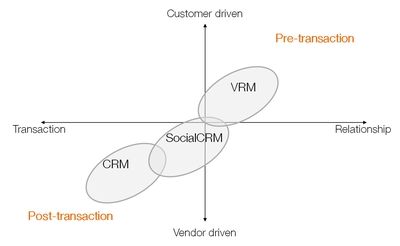The first VRM+CRM workshop will take place on 26-27 August, at Harvard Law School. It’s free. You can register here.
The purpose is to get VRM and CRM developers and other interested parties (such as CRM customers) together to start building out the common ground between them. That common ground is potentially very huge. CRM is already a $15 billion business. What happens when customers start managing relationships too? Let’s start answering that.
A number of VRM tools are now ready for vetting with CRM folks, and CRM interest in connecting to VRM is growing as well. Destination CRM will take place next week in New York. VRM+CRM 2010 will be a perfect place for VRM-CRM discussions started at Destination CRM to continue.
While the workshop sessions will be chosen by the participants (following opening briefings by VRM and CRM folks), here are a few of the topics and questions that are sure to come up —
- Terms of service. How can we get past the legal hurdles and shackles that inconvenience both buyers and sellers when they get acquainted?
- Privacy policies. How can we reduce the suspicions and frictions that these involve?
- Personal data. What tools, methods and services are being developed for individuals to keep track of data they generate or is being kept by sellers and other parties? What means do we have for sharing or exchanging that data in secure and trustable ways?
- Signaling. What new methods will both individuals and organizations have for notifying each other of interests, intentions, policies, preferences, or changes in any of those? How can we make these common across the industry, rather than different for every organization?
- Self-tracking and personal informatics. What vendor-independent means are being developed for individuals to keep track of their own personal data, and manage it?
- Search. What new paradigms for searching are being developed, especially in the context of all the topics above?
- Non-coercive loyalty. What ways are being developed for individuals to express and manage their own forms of loyalty to sellers and other organizations? How can this improve existing loyalty programs?
- Personal RFPs or Advertising in Reverse. How can individual customers notify whole market categories of their intent to purchase a product, safely and securely, without inviting a torrent of promotional jive in response?
- Leveraging base-level protocols, standards and tools. There are hundreds of thousands of free and open source tools, protocols and other goods already in the world, ready to serve as free building materials and guidelines. What can we use of these, and what new ones do we need? What new ones are in development on the VRM side?
- Reducing MLOTT — Money Left On The Table. In our current system, a huge sum of demand goes un-met because of the the means for communicating interest and availability are on the supply side. How (including the means listed above and others) can we equip demand to notify supply of money ready to be spent? In the old days this was seen as “lead generation” by suppliers. But now it’s time to get past that.
- Tie-ins with SCRM. Social CRM is the hottest topic in CRM. How can VRM connect with and through social networking? Important question: Should “social” be restricted to just what can be done through Facebook, Twitter and other commercial services?
- Patient-driven health care. How can individuals be the collection points for their own health data, and the point of origination for what gets done with it?
- API symphonics. The commercial world is increasingly building around a collection of interconnected APIs, or Application Programming Interfaces. Many CRM systems are built around their own APIs. VRM will surely connect into many APIs. How should we be thinking about and guiding evolution here?
- The oppposite of cookies. Sites and companies of all kinds have been keeping track of customers through cookies since the mid-’90s. How can customers do the same with their suppliers?
I’m sure I’ve left some stuff off this list. If you want to add to it, contact me or make a comment below. Better yet, show up and participate.
Look forward to seeing you there.
More details on the event wiki page.







